How the Jurassic Park Franchise May Have Ripped off a Children’s Book Author
Movies Features jurassic park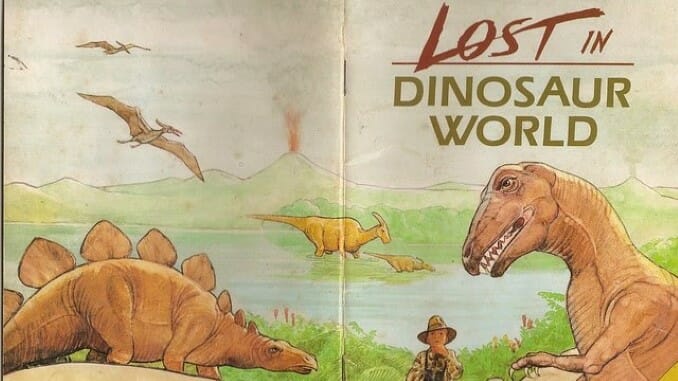
As a child growing up in the 1990s, I went through a long period of infatuation—obsession, really—with dinosaurs. My love of learning about the extinct reptiles was no doubt an early indication for my parents of the geeky bookworm that I would become, and they responded by showering me with all the nonfiction and fiction about dinosaurs I could handle, graciously putting up with an imperious 6-year-old who demanded correct pronunciation of species names, as if the dinosaurs would be offended otherwise. Dinosaur books littered our home, and I absorbed an absurd amount of information that I somehow still partially retain now.
There was one book in particular, though, that captured my attention as a young boy—a fictional account of a futuristic dinosaur amusement park, fraught with danger and thrills. There were scenes of dinosaurs hatching in a nursery, where they were tended like domesticated livestock by uniformed park scientists. There were electric fences, and automated vehicles that shuttled guests around the park. There was a sage dinosaur expert, and a young protagonist named Tim.
Was the book in question Michael Crichton’s classic 1990 novel Jurassic Park? Nope. Absolutely not. I was entirely too young to be diving into Jurassic Park in the early 1990s—what I had was the next best thing, a book called Lost in Dinosaur World by children’s author Geoffrey T. Williams. Here’s the thing, though: Lost in Dinosaur World was first published in 1987—three years before Crichton’s novel became a bestseller that would eventually be adapted as Steven Spielberg’s 1993 blockbuster. As author, Williams immediately cried foul, pointing to the numerous similarities between his work and the work of Crichton, and eventually Spielberg. And in the wake of the film’s massive success, a fed-up Williams brought a lawsuit against Crichton, Spielberg and everyone else in his way, attempting to prove that his copyright on Lost in Dinosaur World had been infringed upon.
Courts ultimately, and perhaps unsurprisingly, sided with the prolific and bestselling novelist, and his friend, the most astoundingly successful motion picture director in history, rather than a relatively unknown children’s book author. The Lost in Dinosaur World lawsuit faded into obscurity, and the Jurassic franchise has subsequently gone on to reap more than $5 billion at the box office alone, not even including the likes of merchandising and spin-offs. Those OG Jurassic Park lunchboxes weren’t free, you know.
But now, with Jurassic World Dominion looming, let’s take a moment to dive back into the strange similarities of Lost in Dinosaur World, an emblem of my childhood that just might have been ripped off into one of the biggest film franchises of all time.
An Adventure in Dinosaur World
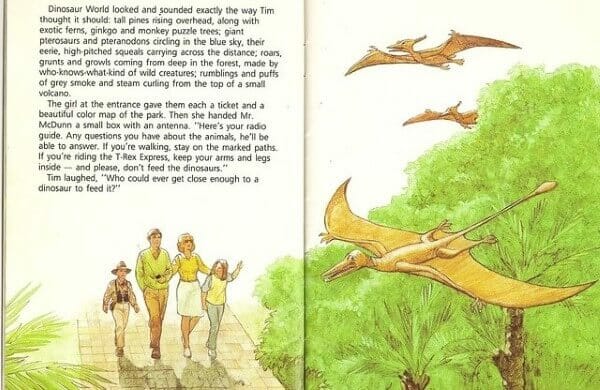
Lost in Dinosaur World was actually only one entry in a series of “Dinosaur World” books by author Geoffrey T. Williams, the second after the original Dinosaur World published in 1985, and followed by Explorers in Dinosaur World and Saber Tooth: A Dinosaur World Adventure in 1988. All four are short children’s adventure stories with some lovely, moderately accurate (in a scientific sense) illustrations, set in an amusement park/nature preserve that features real-life dinosaurs. The book is still available to purchase here and there online, and via Audible you can even hear the audiobook version that I absolutely wore out in a tape player as a dinosaur-obsessed 6-year-old. To this day, the ominous musical cues remain seared into my brain.
The goal of the Dinosaur World books is clearly to be both entertaining for kids and also lightly informative and educational, sprinkling factoids throughout that I can only imagine my parents grew very tired of hearing. Williams, in his lawsuit, described the setting as “an imaginary present day man-made animal park for dinosaurs and other prehistoric animals, where ordinary people can, in presumed safety, visit, tour and observe the creatures in a natural but high-tech controlled habitat.”
That certainly does sound almost indistinguishable from the setting of Jurassic Park, does it not? Williams certainly thought so, but let’s get a bit deeper into the actual events of Lost in Dinosaur World in particular.
The scant, 30-page book follows a young boy named Tim McDunn, improbably bearing the same name, and almost the same age, as the film’s Tim Murphy (they’re even both “T.M.”!), as he journeys to Dinosaur World with his parents and sister. Tim, like myself as a young man, is a somewhat overeager dinosaur obsessive who is determined to see every possible sight the park has to offer, while his parents are rather more restrained in their enthusiasm. After arriving at the park and observing newborn dinosaurs being hatched in the nursery (no B.D. Wong appearance here), this enthusiasm gap results in Tim’s parents and sister buying only a partial tour of the rest of the park, while Tim gets a ticket for the full tour. It’s at this point that we’re introduced to the element I wish had made it into Spielberg’s Jurassic Park, which is a gleaming, life-size Tyrannosaurus-shaped train, dubbed the T-Rex Express. Don’t even try to act like you wouldn’t have wanted to see this chrome monstrosity depicted on film. It is truly glorious.
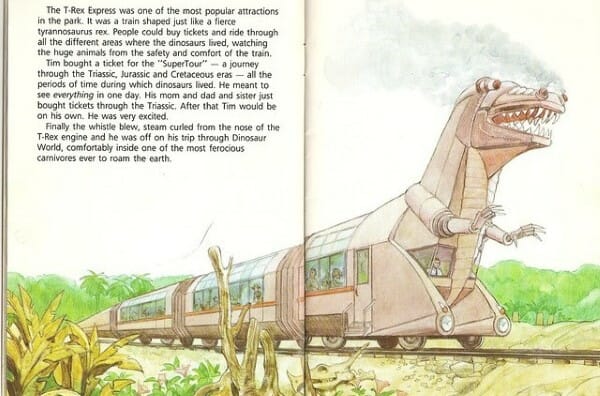
After his parents depart from their portion of the tour, Tim then sets into motion the events that make good on the book title by knocking his electronic guide device out of the train. When he climbs out of the stopped train to retrieve his guide—“How many times have I said, we need locking mechanisms on the vehicle doors!”—the T-Rex Express subsequently leaves without him, leaving Tim stranded in Dinosaur World. He then proceeds to journey through the jungle, encountering various species on the way and learning about them with his electronic guide. Things take a turn for the thrilling when he then encounters an Allosaurus, which chases him until Tim is saved via a narrow escape into the ocean. After more misadventures, Tim is eventually reunited with the T-Rex Express (exciting) and his parents (less exciting).
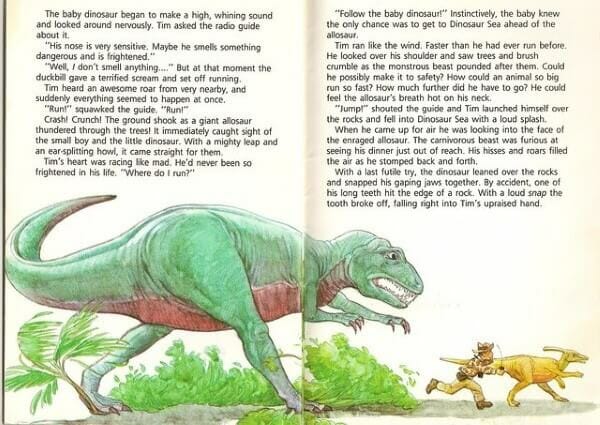
Williams’ lawsuit likewise references certain events from the third book in the series, Explorers in Dinosaur World, which I was not lucky enough to possess as a child. Nevertheless, I can see why Williams thought elements of this book were also potentially being sniped by Crichton, as the main danger of Explorers in Dinosaur World is none other than a pack of raptors who evade the park’s electric fences. Yes, raptors, although these are Deinonychus rather than Velociraptor. As cited in the lawsuit:
After this introduction to the animals of the island, the group walks into the center of the “breathtakingly beautiful” island. Jake warns Peter and Wendy about the deinonychus, carnivorous dinosaurs that “run like the wind, hunt in packs like wolves, are always hungry and have extremely long, sharp claws.” Jake reassures them that “there are special fences that keep dangerous dinosaurs from wandering into the areas where we’ll be going.”
Sounds almost familiar to a certain 1993 blockbuster, does it not? The comparisons are mounting, folks.
As for where author Geoffrey T. Williams is today, information about him online is fairly scant—just the same author profile, sprinkled around half a dozen book websites. Lost in Dinosaur World was clearly at least a modest hit for the author, and he went on to write more educational children’s adventure stories in the mold of it through the 1990s, with titles like Adventures Beyond the Solar System and Treasures of the Barrier Reef. He doesn’t currently seem to have a personal website, or publicly accessible social media, but comments bearing his name can be found on various, older online articles about the Dinosaur World books, suggesting he was apparently online at some point. Mr. Williams, if you’re reading this shoot me an email, won’t you?
The Fate of the Dinosaur World Lawsuit
Armed with the similarities above, Williams tried to take on both Crichton and Spielberg with his lawsuit, but lost both an initial ruling and an appeal. The judgment of the court hinged largely upon the more adult themes of Crichton’s story and Spielberg’s subsequent film—death and dismemberment, coupled with satire on genetic engineering, corporate greed and disdain for environmentalism—that are obviously absent in a children’s book like Lost in Dinosaur World. The many undeniably similar elements, meanwhile, largely fell into territory the court asserted could not be protected under copyright, most notably the general idea of a dinosaur zoo. To quote the legal briefs again:
“The settings of the parties’ works also do not give rise to a finding of substantial similarity. While both the Dinosaur World books and the Jurassic Park works share a setting of a dinosaur zoo or adventure park, with electrified fences, automated tours, dinosaur nurseries, and uniformed workers, these settings are classic scenes a faire that flow from the uncopyrightable concept of a dinosaur zoo. Thus, though perhaps substantially similar, the settings are not protectible. Williams, however, points to the setting of Book III on the island of Pangaea, a lush volcanic island not yet open to the public, and argues that this setting is a protectible expression of the dinosaur zoo idea. We disagree, finding both that Pangaea and Isla Nublar are distinct from one another (one is a man-made theme park attraction, the other a remote natural island) and that placing dinosaurs on a prehistoric island far from the mainland amounts to no more than a scene a faire in a dinosaur adventure story.”
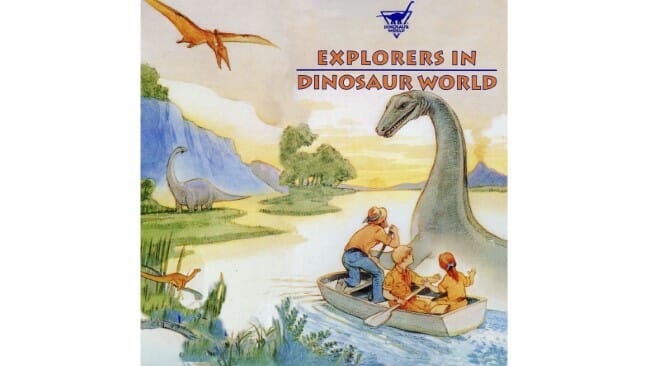
The judgment goes on to conclude the following:
“Turning to specific similarities in the theme, setting, characters, time sequence, plot, and pace, we also find that the Appellees’ works are not substantially similar to the Dinosaur World books. Any similarity in the theme of the parties’ works relates to the unprotectible idea of a dinosaur zoo.”
And there you have it. It probably shouldn’t have been a surprise to Williams that regardless of the outcome, the courts would be substantially more likely to side with literary and Hollywood superstars such as Crichton and Spielberg, but you still have to wonder how the legacy of the Jurassic franchise might have been altered if Williams’ lawsuit had succeeded. So too, do I still find myself wondering whether Crichton could have been aware of Williams’ books as he wrote Jurassic Park. In the author’s own words, Crichton has previously admitted that he originally conceived and wrote his first drafts of Jurassic Park to be told through the eyes of a young boy who is a visitor to the park—a framing device that would have made it even more similar to Lost in Dinosaur World. Regardless, we’ll likely never know the truth of the matter—if Crichton was aware of Williams’ work, it’s not as if he would admit it now.
In a strange, final twist of fate, though, Lost in Dinosaur World would also be adapted as a VHS video of its own in 1993 (the same year as Jurassic Park), featuring animatronic dinosaurs from the Dinamation robotics company responsible for countless “Dinosaurs Alive!” museum shows throughout the 1990s. The results of the 27-minute production, let’s just say … aren’t quite up to the standards of Industrial Light & Magic, as the human actors mostly stand rooted in place and feign fear of the barely articulated dinosaur robots, which are universally incapable of taking a step forward or looking the least bit threatening. The T-Rex Express predictably does not make an appearance. Also, someone thought it was a great idea for three of the 27 minutes to be devoted to a “Dino Deli” singalong number, in which the most embarrassing collection of extras ever assembled each chime in about the virtues of “Heterodont hash!” and “Pachycephalosaurus soup!” If you get nothing else from this piece, I’ll take solace in the fact that you’ll no doubt remember the embarrassment of these actors until the day you die.
I have no idea how involved Geoffrey T. Williams may have been in this adaptation of Lost in Dinosaur World (he has a screenplay credit), or if this was the author’s bitter attempt to cash in on Jurassic Park era dinosaur fever, which he may have on some level felt entitled to. Regardless, it seems safe to say the attempt went pretty poorly, and the video disappeared into the dustbin of 1,000 other projects that parasitically aped Jurassic Park in the early 1990s, alongside copies of Carnosaur and Fred Olen Ray’s Dinosaur Island.
There’s still a chance, though, that it was Williams’ imagination we have to thank for the Jurassic franchise and its billions in box office gross, all these years later. Remember that as Dominion ostensibly brings the series to a close, before its next inevitable resurrection in five years’ time.
Jim Vorel is a Paste staff writer and resident genre geek. You can follow him on Twitter for more film writing.